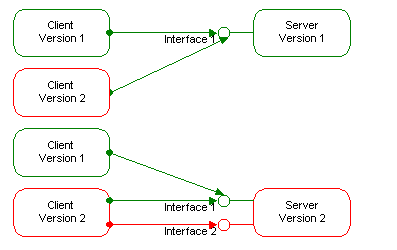
Besides scaling with the number of users or the number of transactions, applications also need to scale as new features are required . Over time, new tasks need to be incorporated and existing ones modified. In the conventional approach, either clients and components have to be updated simultaneously or the old component has to be retained until all clients have upgraded—an undertaking that can become a major administrative burden when a significant number of geographically dispersed sites or users is involved.
DCOM provides flexible evolutionary mechanisms for clients and components. With COM and DCOM, clients can dynamically query the functionality of the component. Instead of exposing its functionality as a single, monolithic group of methods and properties, a COM component can appear differently to different clients. A client that uses a certain feature needs access only to the methods and properties it uses. Clients can also use more than one feature of a component simultaneously. If other features are added to the component, they do not affect an older client that is not aware of them.
Being able to structure components this way, enables a new kind of evolution: the initial component exposes a core set of features as COM interfaces, on which every client can count. As the component acquires new features, most (often even all) of these existing interfaces will still be necessary; and new functions and properties appear in additional interfaces without changing the original interfaces at all. Old clients still access the core set of interfaces as if nothing had changed. New clients can test for the presence of the new interfaces and use them when available, or they can degrade gracefully to the old interfaces.

Figure 8 - Robust Versioning
Because functionality is grouped into interfaces in the DCOM programming model, you can design new clients that run with old servers, new servers that run with old clients, or mix and match to suit your needs and programming resources. With conventional object models, even a slight change to a method fundamentally changes the contract between the client and the component. In some models, it is possible to add new methods to the end of the list of methods, but there is no way to safely test for the new methods on old components. From the network's perspective, things become even more complicated: encoding and wire-representation typically depend on the order of the methods and parameters. Adding or changing methods and parameters also changes the network protocol significantly. DCOM handles all these problems with a single, elegant, unified approach for both the object model and the network protocol.